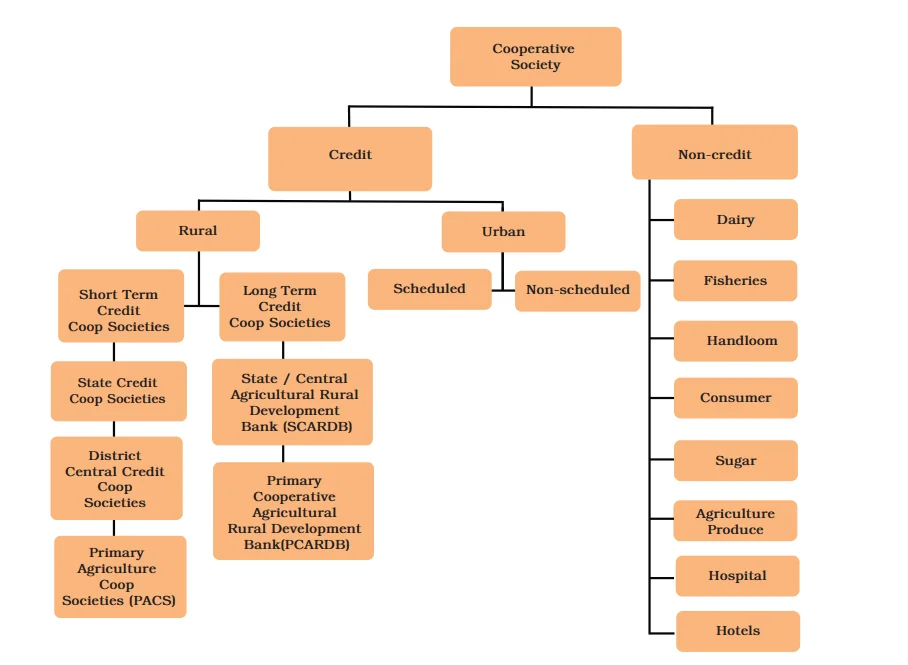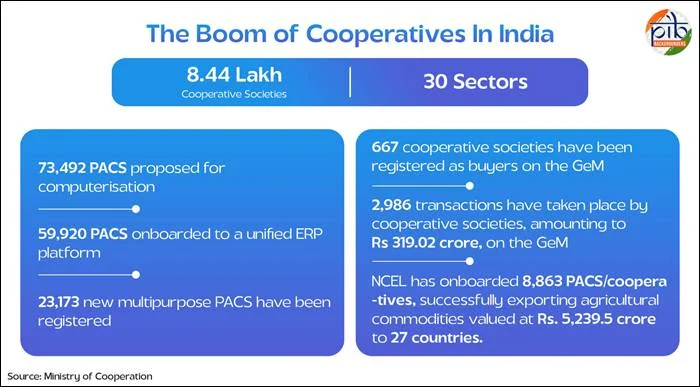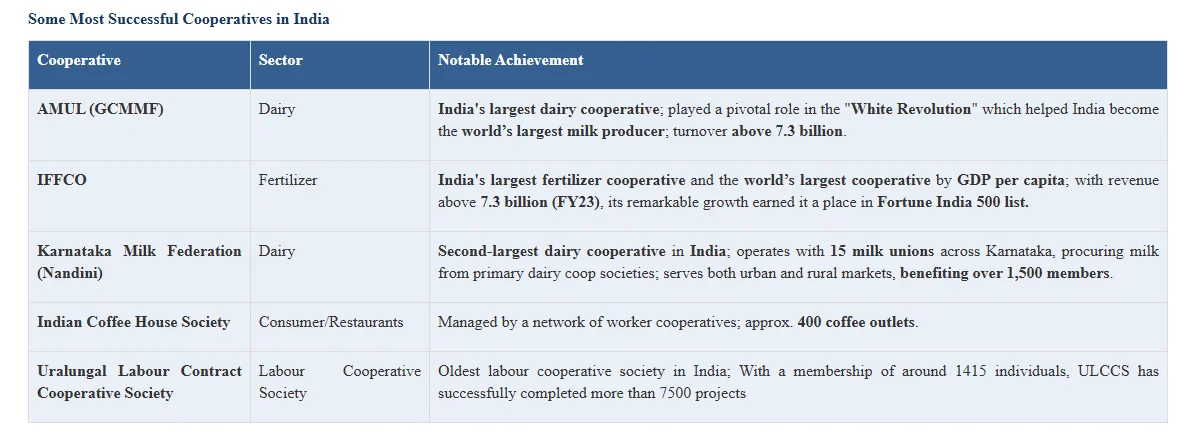National Cooperation Policy 2025 | 26 Jul 2025
For Prelims: Cooperatives, Dairy Infrastructure Development Fund , Primary Agricultural Credit Societies, International Day of Cooperatives, Article 19
For Mains: National Cooperation Policy 2025, Evolution and role of cooperatives in India's socio-economic development
Why in News?
To mark the United Nations-designated International Year of Cooperatives (IYC) 2025, India unveiled the National Cooperation Policy 2025 to transform the cooperative sector into a people-driven economic force.
International Year of Cooperatives (IYC) 2025
- CoopsDay, or the International Day of Cooperatives, has been celebrated since 1923 and was officially recognized by the UN in 1995. It is observed on the first Saturday of July each year.
- The Committee for the Promotion and Advancement of Cooperatives (COPAC) is hosting the IYC 2025.
- Theme of IYC 2025: "Cooperatives Build a Better World", highlighting their role in inclusive, sustainable development and achieving the UN Sustainable Development Goals (SDGs) by 2030.
- Scale of Global Cooperatives:
- Over 12% of the global population is part of the 3 million cooperatives worldwide.
- Cooperatives provide jobs or work opportunities to 280 million people, about 10% of the global workforce.
- The International Cooperative Alliance (ICA) represents over 1 billion cooperative members globally.
What are the Key Features of the National Cooperation Policy 2025?
- Vision and Objective:It supports the Ministry of Cooperation’s mandate of "Sahakar se Samriddhi" by aiming to strengthen cooperatives and expand their grassroots reach.
- The policy replaces the National Policy on Cooperatives in 2002 and sets the course for cooperative growth over the next two decades (2025–2045).
- Convergence of Government Schemes: The policy aims to leverage existing government schemes such as the Dairy Infrastructure Development Fund (DIDF), PM Matsya Sampada Yojana (PMMSY), and the National Programme for Dairy Development (NPDD) to establish 2 lakh new multipurpose Primary Agricultural Credit Societies (M-PACS) within five years.
- Inclusive Growth and Employment: The policy aims to empower rural populations by making cooperatives more inclusive, focusing on Dalits, Adivasis, women, and youth, while strengthening their role in the wider economy.
- Diversification and Education: The policy pushes cooperatives to expand into over 25 sectors like dairy, fisheries, and foodgrain procurement.
- The policy promotes cooperative education via Tribhuvan Sahkari University, India’s first national cooperative university.
- Technological Advancements and Global Engagement: The policy aims to modernise cooperatives to stay competitive in a fast-changing, tech-driven world.
- The policy sets up National Cooperative Exports Limited (NCEL) to help cooperatives access global markets, focusing on exports like rice and wheat.
What are Cooperatives?
- About: A cooperative is an autonomous association of persons united voluntarily to meet their common economic, social and cultural needs, and aspirations through a jointly-owned and democratically-controlled enterprise.
- They follow the principle of "one member, one vote", giving every member equal say, regardless of capital contribution.
- In India, the cooperative movement began in the late 19th century to tackle rural debt and exploitation. Key steps included the Cooperative Acts of 1904 and 1912.
- Post-independence, cooperatives became central to India’s development, with institutions like National Bank for Agriculture and Rural Development (NABARD) and National Cooperative Development Corporation (NCDC) supporting them.
- Another development of cooperatives is the rise of cooperative banks regulated under the Banking Regulation Act, with around 1,400 Urban Cooperative Banks in India.
- Constitutional & Legal Backing: The 97th Amendment, 2011 granted cooperatives constitutional status.
- Article 19(1)(c) ensures the right to form cooperatives, while Article 43B promotes them as a Directive Principles of State Policy (DPSP).
- Part IXB (Articles 243ZH - 243ZT) provides governance provisions for Cooperatives.
- State-level cooperatives fall under the State List, while multi-state cooperatives are governed by the Union List and the Multi-State Cooperative Societies (MSCS) Act, 2002.
- The MSCS Act is administered by the Central Registrar, and state cooperatives are managed by State Registrars.
- The Ministry of Cooperation was established in 2021 by transferring cooperation-related entries from the former Ministry of Agriculture, Cooperation, and Farmers Welfare.
- MSCS (Amendment) Act, 2023 improved governance and transparency of cooperatives.
- Scale of Cooperatives in India: India has nearly 8.42 lakh cooperatives and 29 crore members (27% of the global total) . IFFCO and Amul are among the world’s top 300 cooperatives.
- Maharashtra leads with over 25% of all cooperatives, followed by Gujarat, Telangana, Madhya Pradesh, and Karnataka.
- Tribhuvandas K. Patel led the creation of Amul by organising village dairy cooperatives. Verghese Kurien, the force behind India’s White Revolution, made Amul a national success and turned India into the world’s top milk producer.
What are the Key Initiatives Undertaken by India in the Cooperative Sector?
- PACS: Model bye-laws were introduced to bring uniformity and transparency across states. This helps Primary Agricultural Credit Societies (PACS) function more efficiently and democratically.
- Farmer Producer Organisations (FPOs): As of 2025, around 1,900 FPOs formed in the cooperative sector by NCDC.
- Fish Farmer Producer Organisations (FFPOs) are being promoted to help small fishers with better resources, training, and credit.
- National Cooperative Organics Limited (NCOL) is promoting organic farming through PACS and has launched Bharat Organic products to support sustainable and chemical-free agriculture.
- White Revolution 2.0: Launched in 2024, this initiative aims to increase milk procurement by 50% over the next five years, with over 9,000 dairy cooperative societies already registered.
- Cooperative Banking Reforms: Urban cooperative banks (UCBs) are now allowed to open new branches, while rural cooperative banks can lend to commercial real estate.
- GeM portal: Cooperatives can now register as buyers on the GeM portal to ensure transparent and cost-effective procurement. As of 2024, over 550 cooperatives have been onboarded so far.
What are the Challenges and Opportunities for the Cooperative Sector in India?
Challenges
- Weak Infrastructure: In states like Uttar Pradesh and Bihar, the cooperative network remains underdeveloped. Expanding the reach of cooperatives to these states could be a logistical and financial challenge.
- Low Member Participation: Marginalised communities are underrepresented. Limited awareness and engagement reduce the strength of cooperative functioning.
- Financial Barriers: Many cooperatives, especially those serving poorer sections, struggle to get loans due to lack of collateral or proper documentation.
- Lack of Skills: Many cooperatives lack trained personnel and managerial expertise, affecting performance.
- Technological Integration: While India aims to modernize cooperatives, many societies, especially in rural areas, may face challenges in adopting and implementing new technologies.
Opportunities
- Economic Empowerment: The establishment of two lakh new M-PACS and the expansion of dairy, fishery, and other cooperative sectors offer vast economic opportunities, particularly for rural and agricultural communities.
- Increased Global Presence: The formation of the NCEL and the opening of export markets could help cooperatives gain global recognition, potentially enhancing foreign exchange earnings.
- Job Creation: With cooperatives contributing significantly to sectors like agriculture, dairy, and fisheries, the NCP 2025 can provide millions of new job opportunities, further addressing unemployment in rural areas.
- Improve Governance: Use digital platforms for financial reporting, ensure regular audits, and promote member participation.
Conclusion
Cooperatives are a grassroots movement empowering farmers, women, and small entrepreneurs. They promote inclusive growth and resilient communities. Under the National Cooperation Policy 2025, India reaffirms its commitment to “Sahkar se Samriddhi,” aiming to use cooperatives as a vehicle for sustainable development and widespread prosperity.
|
Drishti Mains Question: The cooperative model has long been a tool for rural empowerment in India. In light of the National Cooperation Policy 2025, critically evaluate how cooperatives can drive inclusive growth. |
UPSC Civil Services Examination, Previous Year Question (PYQ)
Prelims:
Q. With reference to ‘Urban Cooperative Banks’ in India, consider the following statements: (2021)
- They are supervised and regulated by local boards established by State Governments.
- They can issue equity shares and preference shares.
- They were brought under the purview of the Banking Regulation Act, 1949, through a 1966 Amendment.
Which of the above statements are correct?
(a) 1 only
(b) 2 and 3 only
(c) 1 and 3 only
(d) 1, 2 and 3
Ans: (b)
Q. In India, which of the following have the highest share in the disbursement of credit to agriculture and allied activities? (2011)
(a) Commercial Banks
(b) Cooperative Banks
(c) Regional Rural Banks
(d) Microfinance Institutions
Ans: (a)
Mains:
Q. “In the villages itself no form of credit organisation will be suitable except the cooperative society.” – All India Rural Credit Survey. Discuss this statement in the background of agricultural finance in India. What constraints and challenges do financial institutions supplying agricultural finance face? How can technology be used to better reach and serve rural clients? (2014)




